Database Security Report: Analysis of the Oklahoma Data Breach
VerifiedAdded on 2022/08/20
|6
|1165
|22
Report
AI Summary
This report provides a comprehensive analysis of database security, focusing on the real-world example of a data breach in the State of Oklahoma. It delves into the critical importance of securing data to prevent financial losses, comply with regulations, maintain productivity, and build customer trust. The report identifies the causes of data breaches, including poor data management, and details the disadvantages of fictitious data. It also examines the responsibilities associated with data security and the various business risks involved, such as competitive, operational, compliance, program, credit, process, and political risks. Furthermore, the report emphasizes the need for robust security measures to protect sensitive information, employee data, and financial details. The report concludes by highlighting the importance of data integrity and the potential consequences of data breaches, including reputational damage and loss of customer trust, as seen in the Oklahoma case. The report cites several academic sources to support its findings.

unning ead TR H : DA ABASE
0
TDA ABASE
0
TDA ABASE
Paraphrase This Document
Need a fresh take? Get an instant paraphrase of this document with our AI Paraphraser
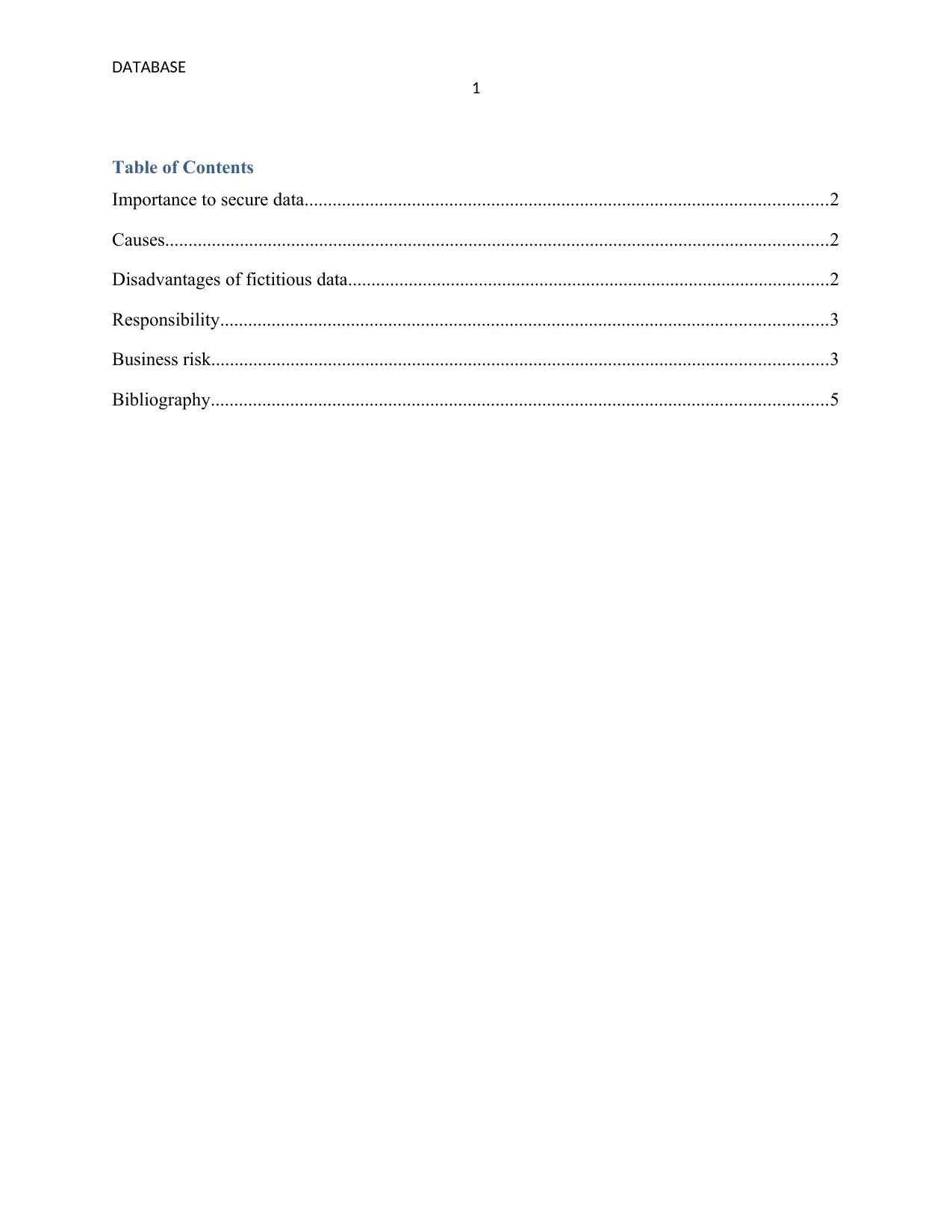
TDA ABASE
1
Table of Contents
Importance to secure data................................................................................................................2
Causes..............................................................................................................................................2
Disadvantages of fictitious data.......................................................................................................2
Responsibility..................................................................................................................................3
Business risk....................................................................................................................................3
Bibliography....................................................................................................................................5
1
Table of Contents
Importance to secure data................................................................................................................2
Causes..............................................................................................................................................2
Disadvantages of fictitious data.......................................................................................................2
Responsibility..................................................................................................................................3
Business risk....................................................................................................................................3
Bibliography....................................................................................................................................5
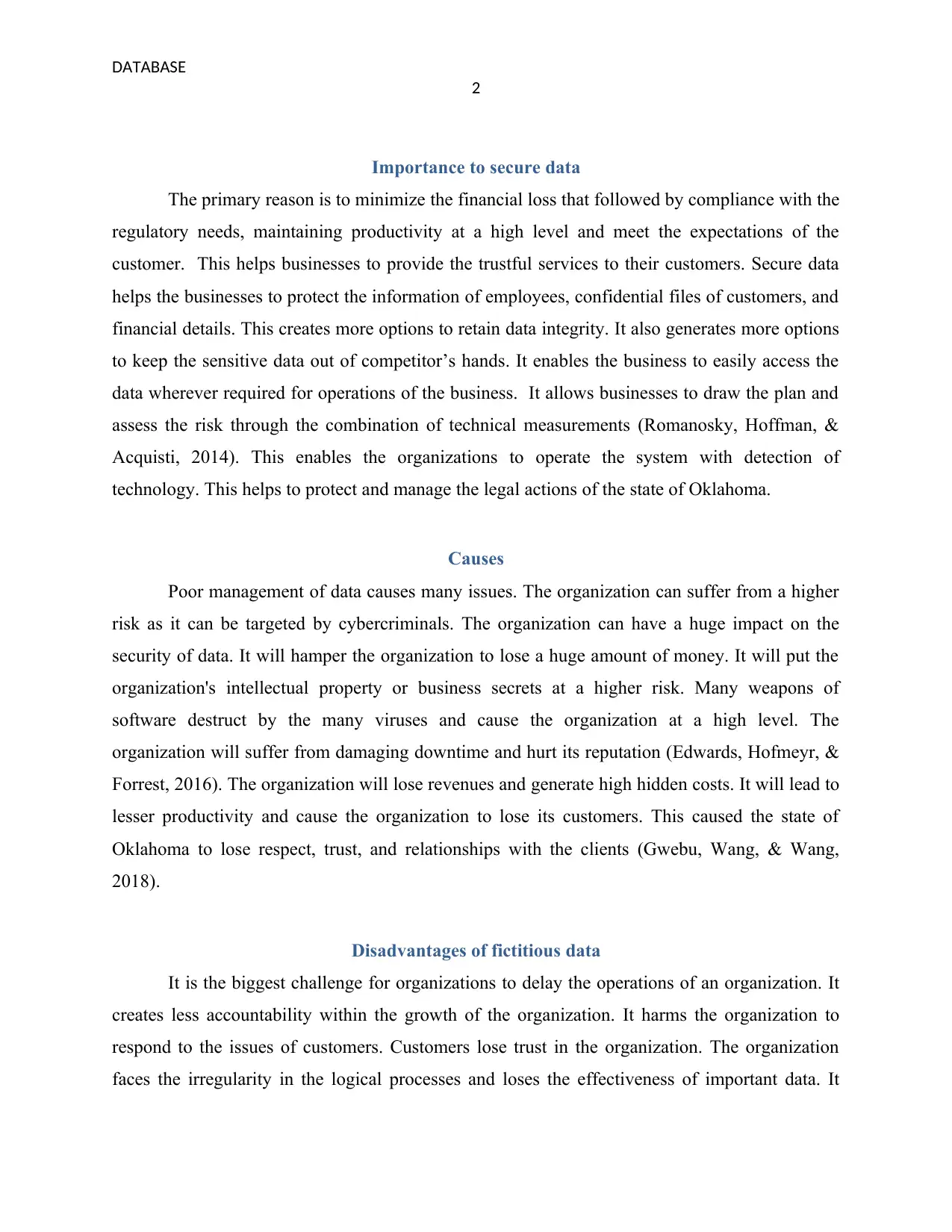
TDA ABASE
2
Importance to secure data
The primary reason is to minimize the financial loss that followed by compliance with the
regulatory needs, maintaining productivity at a high level and meet the expectations of the
customer. This helps businesses to provide the trustful services to their customers. Secure data
helps the businesses to protect the information of employees, confidential files of customers, and
financial details. This creates more options to retain data integrity. It also generates more options
to keep the sensitive data out of competitor’s hands. It enables the business to easily access the
data wherever required for operations of the business. It allows businesses to draw the plan and
assess the risk through the combination of technical measurements (Romanosky, Hoffman, &
Acquisti, 2014). This enables the organizations to operate the system with detection of
technology. This helps to protect and manage the legal actions of the state of Oklahoma.
Causes
Poor management of data causes many issues. The organization can suffer from a higher
risk as it can be targeted by cybercriminals. The organization can have a huge impact on the
security of data. It will hamper the organization to lose a huge amount of money. It will put the
organization's intellectual property or business secrets at a higher risk. Many weapons of
software destruct by the many viruses and cause the organization at a high level. The
organization will suffer from damaging downtime and hurt its reputation (Edwards, Hofmeyr, &
Forrest, 2016). The organization will lose revenues and generate high hidden costs. It will lead to
lesser productivity and cause the organization to lose its customers. This caused the state of
Oklahoma to lose respect, trust, and relationships with the clients (Gwebu, Wang, & Wang,
2018).
Disadvantages of fictitious data
It is the biggest challenge for organizations to delay the operations of an organization. It
creates less accountability within the growth of the organization. It harms the organization to
respond to the issues of customers. Customers lose trust in the organization. The organization
faces the irregularity in the logical processes and loses the effectiveness of important data. It
2
Importance to secure data
The primary reason is to minimize the financial loss that followed by compliance with the
regulatory needs, maintaining productivity at a high level and meet the expectations of the
customer. This helps businesses to provide the trustful services to their customers. Secure data
helps the businesses to protect the information of employees, confidential files of customers, and
financial details. This creates more options to retain data integrity. It also generates more options
to keep the sensitive data out of competitor’s hands. It enables the business to easily access the
data wherever required for operations of the business. It allows businesses to draw the plan and
assess the risk through the combination of technical measurements (Romanosky, Hoffman, &
Acquisti, 2014). This enables the organizations to operate the system with detection of
technology. This helps to protect and manage the legal actions of the state of Oklahoma.
Causes
Poor management of data causes many issues. The organization can suffer from a higher
risk as it can be targeted by cybercriminals. The organization can have a huge impact on the
security of data. It will hamper the organization to lose a huge amount of money. It will put the
organization's intellectual property or business secrets at a higher risk. Many weapons of
software destruct by the many viruses and cause the organization at a high level. The
organization will suffer from damaging downtime and hurt its reputation (Edwards, Hofmeyr, &
Forrest, 2016). The organization will lose revenues and generate high hidden costs. It will lead to
lesser productivity and cause the organization to lose its customers. This caused the state of
Oklahoma to lose respect, trust, and relationships with the clients (Gwebu, Wang, & Wang,
2018).
Disadvantages of fictitious data
It is the biggest challenge for organizations to delay the operations of an organization. It
creates less accountability within the growth of the organization. It harms the organization to
respond to the issues of customers. Customers lose trust in the organization. The organization
faces the irregularity in the logical processes and loses the effectiveness of important data. It
⊘ This is a preview!⊘
Do you want full access?
Subscribe today to unlock all pages.

Trusted by 1+ million students worldwide
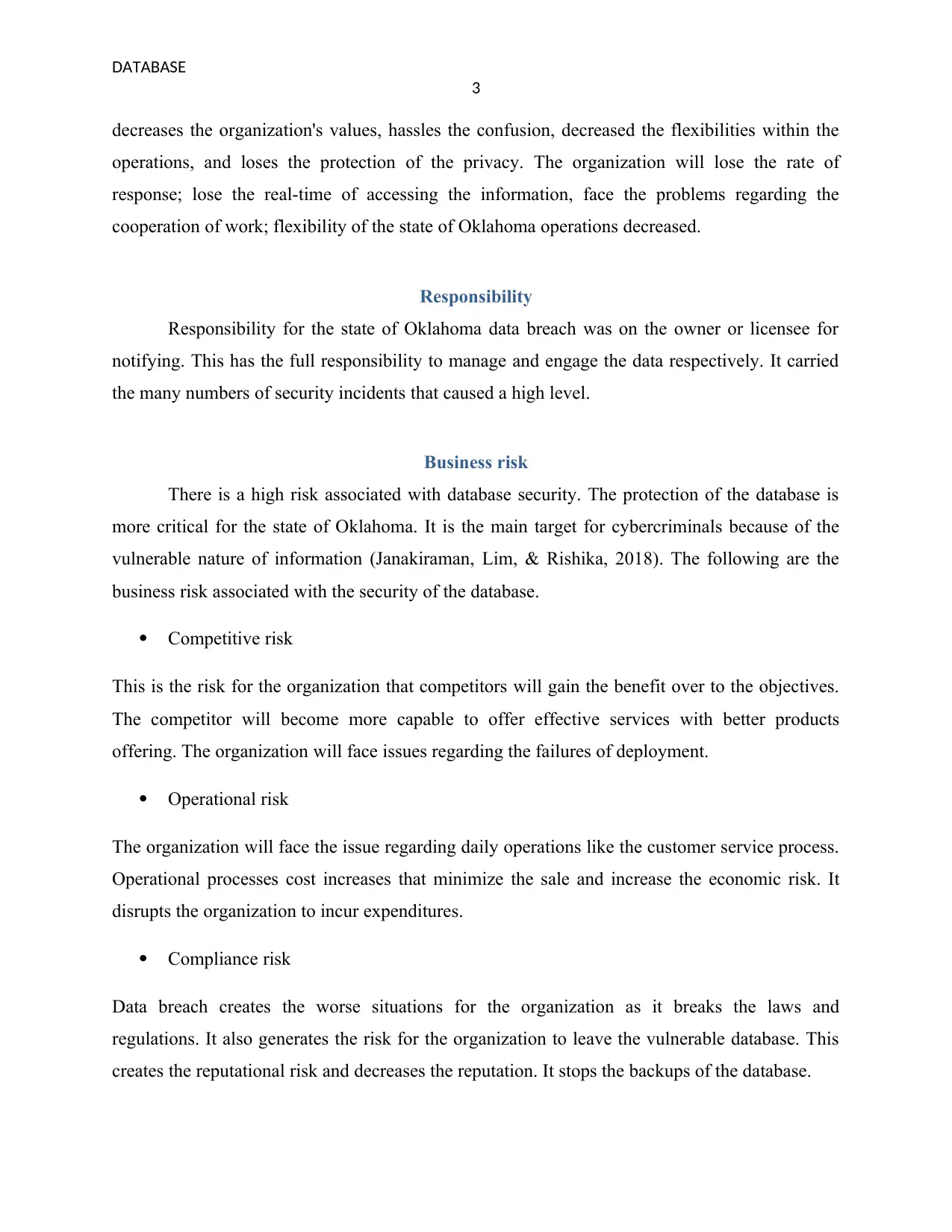
TDA ABASE
3
decreases the organization's values, hassles the confusion, decreased the flexibilities within the
operations, and loses the protection of the privacy. The organization will lose the rate of
response; lose the real-time of accessing the information, face the problems regarding the
cooperation of work; flexibility of the state of Oklahoma operations decreased.
Responsibility
Responsibility for the state of Oklahoma data breach was on the owner or licensee for
notifying. This has the full responsibility to manage and engage the data respectively. It carried
the many numbers of security incidents that caused a high level.
Business risk
There is a high risk associated with database security. The protection of the database is
more critical for the state of Oklahoma. It is the main target for cybercriminals because of the
vulnerable nature of information (Janakiraman, Lim, & Rishika, 2018). The following are the
business risk associated with the security of the database.
Competitive risk
This is the risk for the organization that competitors will gain the benefit over to the objectives.
The competitor will become more capable to offer effective services with better products
offering. The organization will face issues regarding the failures of deployment.
Operational risk
The organization will face the issue regarding daily operations like the customer service process.
Operational processes cost increases that minimize the sale and increase the economic risk. It
disrupts the organization to incur expenditures.
Compliance risk
Data breach creates the worse situations for the organization as it breaks the laws and
regulations. It also generates the risk for the organization to leave the vulnerable database. This
creates the reputational risk and decreases the reputation. It stops the backups of the database.
3
decreases the organization's values, hassles the confusion, decreased the flexibilities within the
operations, and loses the protection of the privacy. The organization will lose the rate of
response; lose the real-time of accessing the information, face the problems regarding the
cooperation of work; flexibility of the state of Oklahoma operations decreased.
Responsibility
Responsibility for the state of Oklahoma data breach was on the owner or licensee for
notifying. This has the full responsibility to manage and engage the data respectively. It carried
the many numbers of security incidents that caused a high level.
Business risk
There is a high risk associated with database security. The protection of the database is
more critical for the state of Oklahoma. It is the main target for cybercriminals because of the
vulnerable nature of information (Janakiraman, Lim, & Rishika, 2018). The following are the
business risk associated with the security of the database.
Competitive risk
This is the risk for the organization that competitors will gain the benefit over to the objectives.
The competitor will become more capable to offer effective services with better products
offering. The organization will face issues regarding the failures of deployment.
Operational risk
The organization will face the issue regarding daily operations like the customer service process.
Operational processes cost increases that minimize the sale and increase the economic risk. It
disrupts the organization to incur expenditures.
Compliance risk
Data breach creates the worse situations for the organization as it breaks the laws and
regulations. It also generates the risk for the organization to leave the vulnerable database. This
creates the reputational risk and decreases the reputation. It stops the backups of the database.
Paraphrase This Document
Need a fresh take? Get an instant paraphrase of this document with our AI Paraphraser
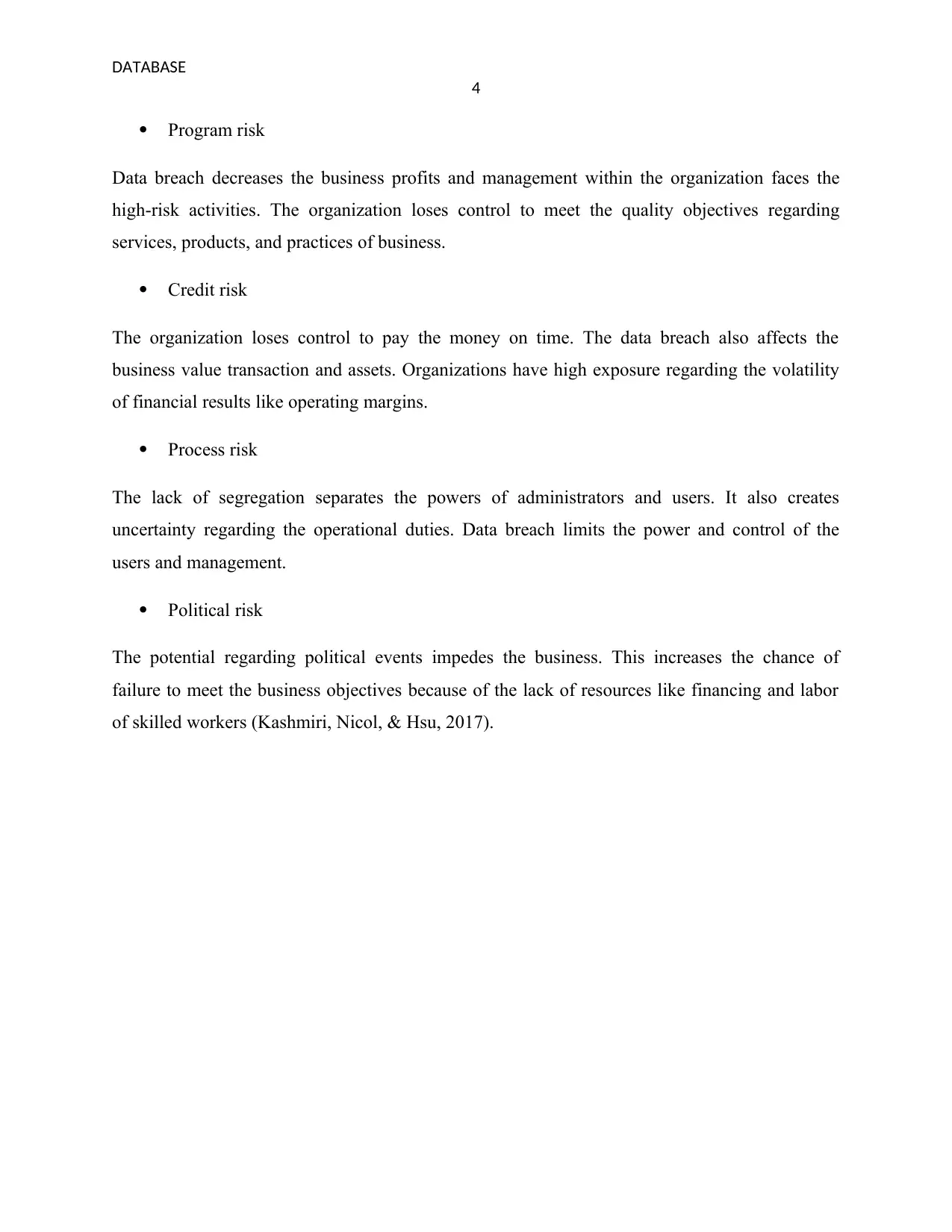
TDA ABASE
4
Program risk
Data breach decreases the business profits and management within the organization faces the
high-risk activities. The organization loses control to meet the quality objectives regarding
services, products, and practices of business.
Credit risk
The organization loses control to pay the money on time. The data breach also affects the
business value transaction and assets. Organizations have high exposure regarding the volatility
of financial results like operating margins.
Process risk
The lack of segregation separates the powers of administrators and users. It also creates
uncertainty regarding the operational duties. Data breach limits the power and control of the
users and management.
Political risk
The potential regarding political events impedes the business. This increases the chance of
failure to meet the business objectives because of the lack of resources like financing and labor
of skilled workers (Kashmiri, Nicol, & Hsu, 2017).
4
Program risk
Data breach decreases the business profits and management within the organization faces the
high-risk activities. The organization loses control to meet the quality objectives regarding
services, products, and practices of business.
Credit risk
The organization loses control to pay the money on time. The data breach also affects the
business value transaction and assets. Organizations have high exposure regarding the volatility
of financial results like operating margins.
Process risk
The lack of segregation separates the powers of administrators and users. It also creates
uncertainty regarding the operational duties. Data breach limits the power and control of the
users and management.
Political risk
The potential regarding political events impedes the business. This increases the chance of
failure to meet the business objectives because of the lack of resources like financing and labor
of skilled workers (Kashmiri, Nicol, & Hsu, 2017).
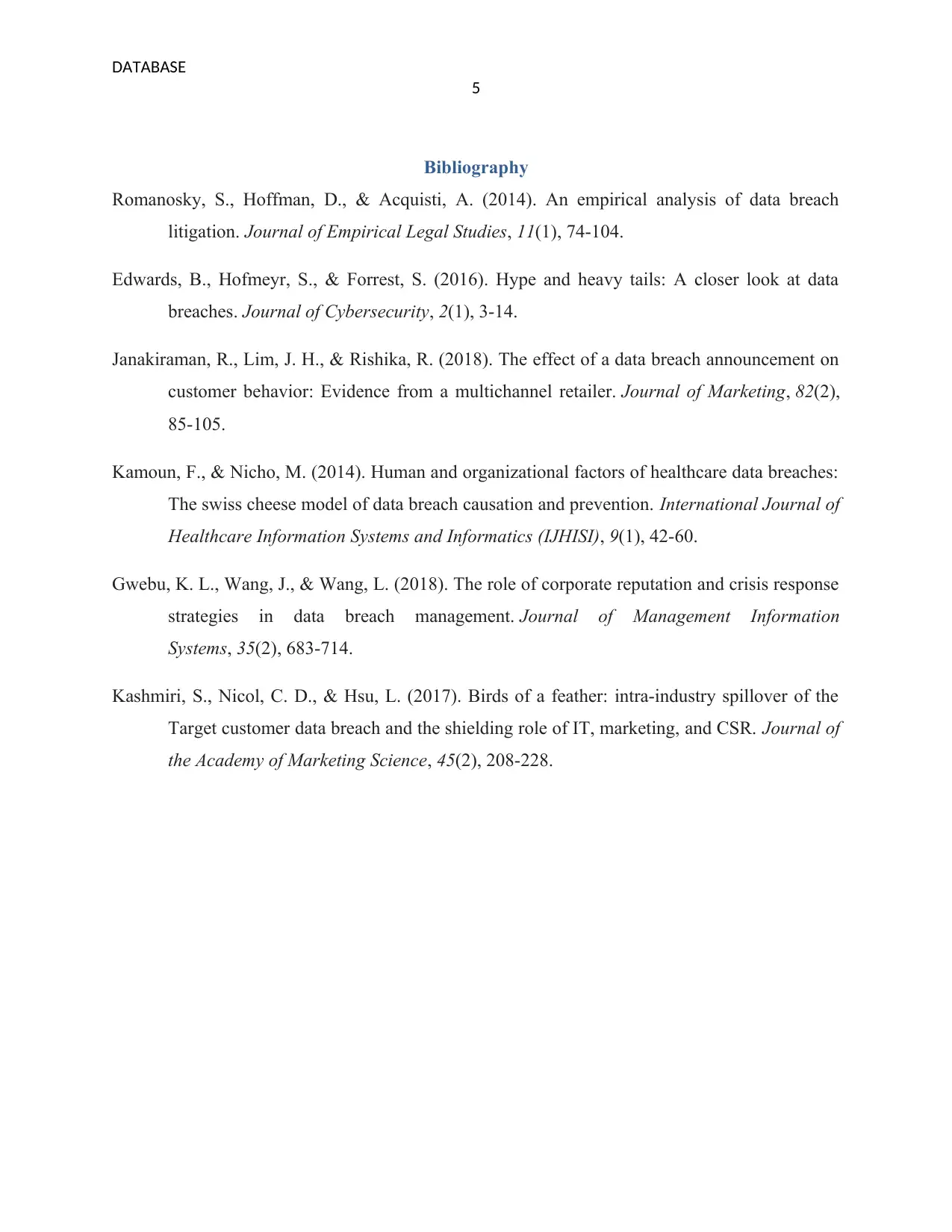
TDA ABASE
5
Bibliography
Romanosky, S., Hoffman, D., & Acquisti, A. (2014). An empirical analysis of data breach
litigation. Journal of Empirical Legal Studies, 11(1), 74-104.
Edwards, B., Hofmeyr, S., & Forrest, S. (2016). Hype and heavy tails: A closer look at data
breaches. Journal of Cybersecurity, 2(1), 3-14.
Janakiraman, R., Lim, J. H., & Rishika, R. (2018). The effect of a data breach announcement on
customer behavior: Evidence from a multichannel retailer. Journal of Marketing, 82(2),
85-105.
Kamoun, F., & Nicho, M. (2014). Human and organizational factors of healthcare data breaches:
The swiss cheese model of data breach causation and prevention. International Journal of
Healthcare Information Systems and Informatics (IJHISI), 9(1), 42-60.
Gwebu, K. L., Wang, J., & Wang, L. (2018). The role of corporate reputation and crisis response
strategies in data breach management. Journal of Management Information
Systems, 35(2), 683-714.
Kashmiri, S., Nicol, C. D., & Hsu, L. (2017). Birds of a feather: intra-industry spillover of the
Target customer data breach and the shielding role of IT, marketing, and CSR. Journal of
the Academy of Marketing Science, 45(2), 208-228.
5
Bibliography
Romanosky, S., Hoffman, D., & Acquisti, A. (2014). An empirical analysis of data breach
litigation. Journal of Empirical Legal Studies, 11(1), 74-104.
Edwards, B., Hofmeyr, S., & Forrest, S. (2016). Hype and heavy tails: A closer look at data
breaches. Journal of Cybersecurity, 2(1), 3-14.
Janakiraman, R., Lim, J. H., & Rishika, R. (2018). The effect of a data breach announcement on
customer behavior: Evidence from a multichannel retailer. Journal of Marketing, 82(2),
85-105.
Kamoun, F., & Nicho, M. (2014). Human and organizational factors of healthcare data breaches:
The swiss cheese model of data breach causation and prevention. International Journal of
Healthcare Information Systems and Informatics (IJHISI), 9(1), 42-60.
Gwebu, K. L., Wang, J., & Wang, L. (2018). The role of corporate reputation and crisis response
strategies in data breach management. Journal of Management Information
Systems, 35(2), 683-714.
Kashmiri, S., Nicol, C. D., & Hsu, L. (2017). Birds of a feather: intra-industry spillover of the
Target customer data breach and the shielding role of IT, marketing, and CSR. Journal of
the Academy of Marketing Science, 45(2), 208-228.
⊘ This is a preview!⊘
Do you want full access?
Subscribe today to unlock all pages.

Trusted by 1+ million students worldwide
1 out of 6
Related Documents
Your All-in-One AI-Powered Toolkit for Academic Success.
+13062052269
info@desklib.com
Available 24*7 on WhatsApp / Email
![[object Object]](/_next/static/media/star-bottom.7253800d.svg)
Unlock your academic potential
Copyright © 2020–2025 A2Z Services. All Rights Reserved. Developed and managed by ZUCOL.





